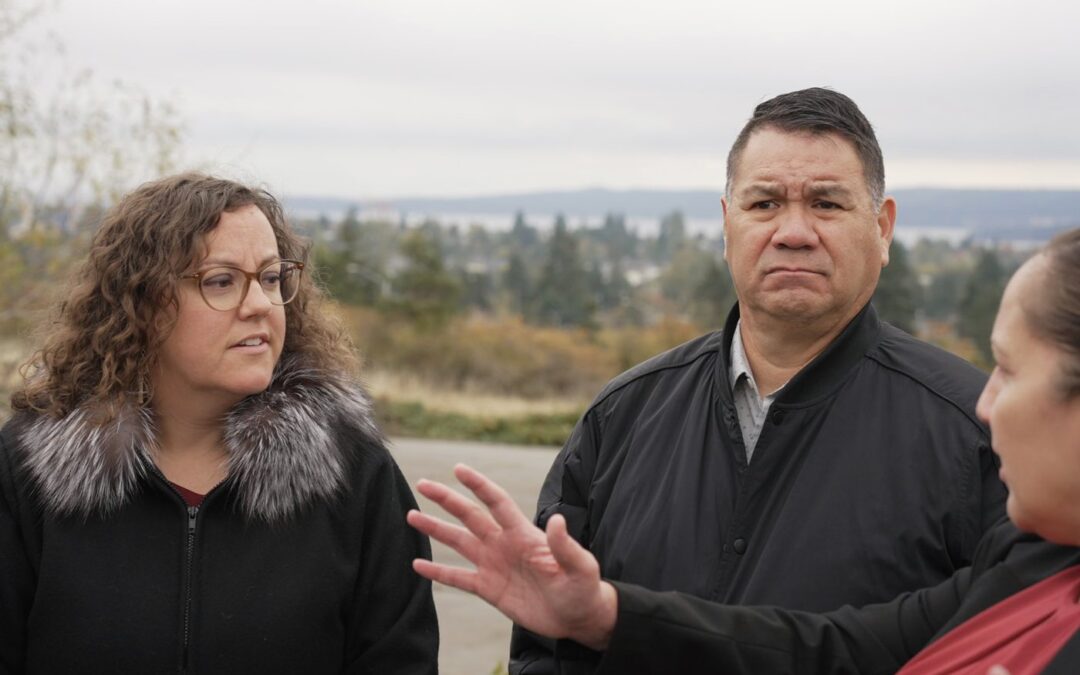Photo: Rebecca Alty, federal minister of Crown-Indigenous Relations and Northern Affairs and Mike Wyse, chief of Snuneymuxw First Nation, in conversation at the 194.7-acre former military site adjacent to Vancouver Island University in Nanaimo on Oct. 16, 2025 / photo by Sonal Gupta / LJI
By Sonal Gupta
Local Journalism Initiative Reporter
Canada’s National Observer
The First Nation with the least reserve land per person in British Columbia has reclaimed a swath of ancestral territory on Vancouver Island once fenced off for the federal military.
The 80 hectares of land, known traditionally as te’tuxwtun, or Mount Benson, was taken from Snuneymuxw First Nation by the government in the mid-1800s and used by the Department of National Defence. It later became the Nanaimo Indian Hospital from 1946 to 1967 — a site where many Indigenous people suffered under Canada’s forced assimilation policies.
“Snuneymuxw never surrendered our land,” Mike Wyse, chief of the nation, told Canada’s National Observer. “We signed a treaty that we had our understanding, but our understanding of the English language wasn’t as clear as it is today. Once we signed, our lands were being sold and it took us that long to get back to the table and negotiate in good faith.”
Now that land is returned through Canada’s addition-to-reserve process — a system that allows Indigenous communities to propose and have land officially added to their reserve.
“Recognizing these lands as Snuneymuxw isn’t just about addressing the wrongs of the past, it’s also about building a stronger future,” said Rebecca Alty, federal minister of Crown-Indigenous Relations and Northern Affairs, at a press conference announcing the handover on Thursday.
The transfer includes three federal parcels totalling 194.7 acres adjacent to Vancouver Island University in Nanaimo.
Over the past two and a half years, the community has been involved in planning for the future use of this land. They envision a mixed-use development that will include various types of housing — addressing the chronic shortage faced by many community members.
“There’s so much homelessness out there, just not enough housing. We want to give them an opportunity to come home, look after their health and wellness — it’s our duty to look after our people,” Wyse said.
The plan will also include commercial spaces, cultural and recreational facilities. Wyse said they are in discussions with businesses interested in bringing their operations to the region and are considering options, such as student housing and other educational facilities connected to the university.
“We need income to survive. We need income to move forward. This can be an opportunity to create a revenue stream for the nation,” he said.
Earlier this year, the Snuneymuxw First Nation’s Teytexen Village Specific Claim settlement agreement was finalized. Under this agreement, Canada provided $42 million in compensation to the nation for the Crown’s failure to set aside village lands promised under the 1854 Snuneymuxw Sarelquun (Douglas) Treaty.
This failure deprived the First Nation of the use and benefit of those lands for generations.The resolution of this claim is another example of Snuneymuxw’s leadership in advancing reconciliation and justice, Alty said.
The addition-to-reserve process allows First Nations to expand their land base for housing, infrastructure, schools and health services, while also supporting economic development opportunities, such as businesses, partnerships and resource management. But since 1972, the policy has had only small changes and faced criticism for being slow and complex. To address this, the federal Budget 2021 invested $43 million to work closely with First Nations to speed up requests.
“Across the country, Additions-to-Reserve support self-determination and are a powerful tool for advancing economic development. That’s why we are focused on improving the process and why, last year, we introduced changes to make it clearer and faster,” said a spokesperson from the office of Crown-Indigenous Relations and Northern Affairs Canada. “We’re now co-developing a new policy with First Nations. One that reflects Indigenous priorities and the speed at which we need to move together.”
In July 2025, more than 700 hectares of land on te’tuxwtun (Mount Benson) were officially transferred back to the Snuneymuxw First Nation by the province of BC as part of a 2020 land agreement that will return over 3,000 hectares to the nation.
“There’s a big spiritual connection to the lands that are called and upheld today,” Wyse said. “To receive any pieces of land that our ancestors once walked and lived on, and thrived on, is big.”
